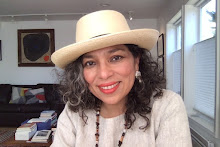Like for so many the pandemic lockdown forced a deep reckoning of my life's journey thus far. Those weeks surrendered indoors, I considered my emotional, spiritual, physical worlds and also less taxing, practical aspects of my life. I became a cleaning devil, purging kitchen cupboards, thinning closets, streamlining garage and book shelves.
Scrutinizing my closet resulted in the awareness that I dressed in large part imitating a version of cool I adopted back in my college days. Now at my current age surely an outdated version of cool. Certainly, someone else's version of cool. My wardrobe told me that I wanted to look smart, sophisticated. It told
me that I wanted to look some version of a writer—Don't ask me which
writer because I would not have known what to say, still don't—I could
not articulate a specific person but I could identify a color: black.
For far too long my clothing choices centering black garments chased an idea predicated on a kind of negation: If you dress in black, you are a "somebody," you "belong" in some smart club, if you fail to dress that way ... then never mind you.
My wardrobe told me that I sought approval. I wanted to belong. And yes, clothing is one way humans for millenia have announced their belonging to ethnic, cultural, linguistic, religious, and many other groups. In those cases stitch patterns, paint patterns, thread colors, garment shapes, announce belonging to a collective. But my effort was an individual search. Mine was a lonely endeavor to belong to a class of people.
COVID changed my priorities. I realized that the club I wanted to belong to was the club I wanted to belong to, not the club I thought I should belong to.
There was plenty evidence among my things that color and embroidered textiles are important to me. I've collected colorful huipiles and rebozos for years. I own shoes, skirts, shirts in bright saturated colors and intricate patterns. What changed during the lockdown is that color took center stage. I did not want to use my colorful clothes to accentuate black outfits, but to make them be the outfit.
I wanted my clothes to say, I am alive! I am alive! Not, "I'm trying to
be smart." And if that earned me the epithet of eccentric, odd, badly
dressed, "crazy lady" then so be it.
I wanted to wear clothing with handmade details, wear designs are steeped in tradition and story, wisdom, and joy. I may not understand the intricate significance of each detail in a huipil, but the garments and the colors link me to the native peoples of Central America from whom I descend.
This desire to live in color, to be affirmed by it, reminded me of Celie in The Color Purple. To feel alive and feel God's grace on my face on a sunny morning, or be refreshed by cool sand under my feet, to say Yes! to a tomato, to marvel at a patch of zinnias, or a field of heather, to let color enter me, is to feel the deepest belonging.



